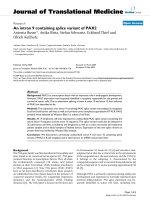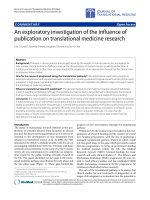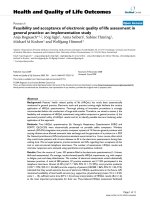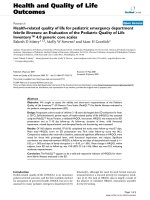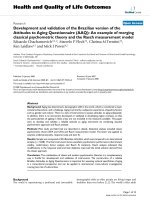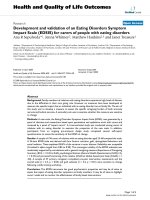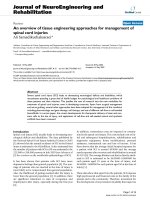Báo cáo hóa học: " An antigenic epitope of influenza virus nucleoprotein (NP) associated with polymeric forms of NP" ppt
Bạn đang xem bản rút gọn của tài liệu. Xem và tải ngay bản đầy đủ của tài liệu tại đây (360.81 KB, 5 trang )
BioMed Central
Page 1 of 5
(page number not for citation purposes)
Virology Journal
Open Access
Short report
An antigenic epitope of influenza virus nucleoprotein (NP)
associated with polymeric forms of NP
Elena N Prokudina*
1
, Nataly Semenova
1
, Valery Chumakov
1
and
Lothar Stitz
2
Address:
1
The D.I. Ivanovsky Institute of Virology, Gamaleya str. 16, Moscow, Russia and
2
Friedrich-Loeffler-Institut, D-72076 Tubingen, Germany
Email: Elena N Prokudina* - ; Nataly Semenova - ; Valery Chumakov - ;
Lothar Stitz -
* Corresponding author
Abstract
Intracellular influenza virus nucleoprotein (NP) is characterized by a high efficiency of homo-
polymers formation, however their antigenic structure is still incompletely known. Herein, we
report that RNase-resistant intracellular NP homo-polymers have a highly ordered conformational
antigenic epitope, which depends on inter-subunit interactions of monomeric NPs. Our studies
have shown that in radioimmunoprecipitation (RIPA) intracellular NP polymers bind mAb N5D3
and RNase does not prevent their mAb binding. In contrast to NP polymers, NP monomeric
subunits, obtained by thermo-dissociation of NP polymers, fail to bind the mAb N5D3 in RIPA. At
the same time, the in vitro concentration of thermo-denatured monomeric NPs in both soluble and
immobilized forms results in NP-NP association, accompanied by renaturation of the N5D3
epitope. The same results were detected by Western blotting, where the pre-denatured NP
monomers were concentrated on nitrocellulose into a single 56 kDa band, which then caused NP-
NP self-association as well as N5D3 epitope renaturation. Thus, the in vitro renaturation of N5D3
epitope is markedly dependent on NP monomers concentration.
The results obtained suggest that in vivo formation and in vitro renaturation of the N5D3 epitope
depend on inter-subunit interactions of monomeric NPs and NP-NP interactions influence the
antigenic structure of the influenza virus NP polymers.
Findings
It is known that intracellular nucleoprotein (NP) is capa-
ble of self-associating to form large RNA-free homo-poly-
meric complexes [1,2], which are morphologically similar
to the intact viral RNP [3-5]. We have previously shown
that numerous types of RNase resistant thermo-sensitive
NP polymers are detected in influenza virus infected
MDCK cells [6-8]. After heating, NP polymers are dissoci-
ated exclusively into NP monomeric subunits. It is also
known that protein-protein interactions induce confor-
mational changes at interfaces of subunits. As a result,
those polymerizing proteins may acquire new biological
properties, including the exposure of new conformational
epitopes [9,10]. The antigenic structure of intracellular
influenza virus NP homo-polymers is still unknown.
In the present study, we have analyzed the total intracellu-
lar influenza virus NP polymers and demonstrated in vivo
formation and in vitro renaturation of the antigenic
epitope depending on NP-NP association.
Published: 29 February 2008
Virology Journal 2008, 5:37 doi:10.1186/1743-422X-5-37
Received: 15 February 2008
Accepted: 29 February 2008
This article is available from: />© 2008 Prokudina et al; licensee BioMed Central Ltd.
This is an Open Access article distributed under the terms of the Creative Commons Attribution License ( />),
which permits unrestricted use, distribution, and reproduction in any medium, provided the original work is properly cited.
Virology Journal 2008, 5:37 />Page 2 of 5
(page number not for citation purposes)
Influenza A/Duck/Ukraine/63(H3N8) and MDCK
(Madin Darbin Canine Kidney) cells were used. The NP
was detected using rabbit anti-NP polyclonal antibody [1]
and anti-NP mAbs.
For mAb generation, the intracellular influenza virus NP
isolated from chorionallantoic membranes of embryo-
nated chicken eggs infected with A/FPV/Rostock/
34(H7N1) influenza virus was used. Intracellular NP was
purified by immunoaffinity chromatography and isoelec-
tric focusing [1,11]. For the present study, a monoclonal
antibody against NP designated mAb N5D3 was selected.
For metabolic labeling of the infected cells, [
35
S] methio-
nine (50 μCi/ml) was introduced into the medium for 1
hr at 5 hrs p.i. Before SDS-PAGE analysis the cell lysate
was divided into two portions: one portion was left
unheated to preserve NP polymers, and the other was
heated for 40 min at 70°C (or 3 min at 100°C) to disso-
ciate NP polymers into NP monomeric subunits. Both
unheated and pre-heated portions were analysed by RIPA,
Dot-blot assay and Western blotting.
RIPA, Western blot and Dot-blot assays were carried out as
described [6,12].
In the first series of experiments, we compared the mAb
N5D3 binding capacity of intracellular NP polymers with
their solubilized monomeric subunits using RIPA and
Western blot.
As shown in Fig. 1A the polyclonal antibodies (Abs)
reacted in a RIPA with both polymeric NPs, which were
present in the unheated cytosol (lane 1), and monomeric
56 kDA NPs, which were a result of thermo-dissociation
of NP polymers (lane 2). As also shown NP polymers were
recognized by mAb N5D3 in unheated cytosol (lane 3).
The pre-treatment of cytosol with RNase did not influence
the ability of NP polymers to bind mAb N5D3 (not
shown). In contrast to NP polymers, the soluble 56 kDa
The capacity of polymeric and monomeric NP to bind mAb N5D3Figure 1
The capacity of polymeric and monomeric NP to bind mAb N5D3. A) RIPA. Radiolabeled cytosol of infected cells
was divided into unheated (r.t) portion, containing NP polymers and the heated (70° C) portion, containing NP 56 kDa mono-
mers as a result of NP polymers dissociation. Both unheated and pre-heated portions were subjected to RIPA using polyclonal
anti-NP Abs or mAb N5D3. SDS-PAGE of the immunoprecipitates obtained by RIPA using polyclonal Abs (lanes 1, 2) and mAb
N5D3 (lanes 3,4). B) Immunolotting. Radiolabeled unheated (1,3) and pre-heated (2,4) cytosols were subjected to SDS-PAGE,
followed by Western blot, including electro-transfer onto nitrocellulose membrane, autoradiography and immunodetection
using mAb N5D3. Autoradiography (lanes 1, 2) and immunostaining using mAb N5D3 (lanes 3,4) of membrane containing blot-
ted proteins. C) Renaturation of N5D3 epitope caused by self-association of the concentrated soluble NP monomers. The
non-concentrated m-NP before RIPA (lane 1) and after immunosorption by RIPA using mAb N5D3 (lane 2). The concentrated
soluble self-associated m-NP (as described in the text) before RIPA (lane 3) and after immunosorption by RIPA using mAb
N5D3 (lane 4). The aliquot of RIPA immunoprecipitate shown in lane 4 was heated at 100°C for 3 min before SDS-PAGE (lane
5). The samples shown in lanes 1–4 were not additionally pre-heated before SDS-PAGE.
Virology Journal 2008, 5:37 />Page 3 of 5
(page number not for citation purposes)
NP monomers formed after thermo-dissociation of NP
polymers were not recognized by mAb N5D3 in a RIPA
(lane 4). A trivial explanation could be that the conforma-
tional N5D3 epitope is present not only in polymeric NPs
but also in monomeric NP subunits, but as a result of the
heating process, this epitope is denatured and destroyed.
If this assumption is correct, the 56 kDa NP monomers
transferred onto nitrocellulose after heating and denatur-
ing SDS-PAGE should not be recognized by mAb N5D3 in
a Western blot, as they were not recognized in the heated
cytosol by a RIPA (shown in Fig. 1A, lane 4).
To study the mAb N5D3 binding ability of monomeric
NPs in a Western blot, the unheated and pre-heated radi-
olabeled cytosols were subjected to denaturing SDS-PAGE
followed by transfer onto nitrocellulose membrane. Fig.
1B shows the pattern of the total intracellular proteins
detected on nitrocellulose by autoradiography (lanes 1,
2), and the same proteins immunostained using the mAb
N5D3 (lanes 3, 4). The immunostaining results showed
that in the unheated sample mAb N5D3 recognized the
immobilized NP-polymers (lane 3). RNase treatment of
immobilized NP polymers did not decrease their mAb
N5D3 binding capacity (not shown). It is also shown in
Fig. 1 that in contrast to RIPA (Fig. 1A, lane 4), the
thermo-denatured 56 kDa NP monomers were efficiently
recognized by mAb N5D3 in Western blot analysis (Fig.
1B, lane 4).
One of the reasons for the differences in immunodetec-
tion of monomeric NP between RIPA and Western blot
may be the difference in concentrations of monomeric
NPs in the two analyses. According to a calibration curve
of Coomassie staining (not shown), ~1 μg of monomeric
NPs in a single 56 kDa band (shown in Fig. 1B, lanes 2
and 4) localized on a membrane in a volume of about 1
mm
3
in the Western blot (5 mm × 2 mm × 0.1 mm corre-
sponding to length × width × depth of the 56 kDa NP
band). However, before electrophoresis, the same 1 μg of
monomeric NPs was present in 50 mm
3
of initial cytosol.
Therefore, ~0.02 μg/mm
3
of monomeric NP was in the
initial cytosol detected in a RIPA and ~1 μg/mm
3
of mon-
omeric NPs was in a 56 kDa band detected in a Western
blot. The ~50-fold increase of NP concentration on the
membrane in a Western blot leads to shortening in the
intermolecular distances, and this presumably promotes
NP-NP association, accompanied by N5D3 epitope rena-
turation.
In further experiments, the dependence of N5D3-epitope
renaturation on the concentration of monomeric NPs was
studied in both soluble and immobilized forms of NPs.
For this aim the solution containing the radiolabelled pol-
ymeric NPs (about 1000 ng/ml) was obtained by N5D3-
mAb-mediated affinity chromatography [11] using the
unheated cytosol. The purified polymeric NPs were
divided into an unheated portion containing only poly-
meric NPs (p-NP) and a heated portion containing only
monomeric NPs (m-NP).
To concentrate the monomeric NPs in a soluble form, the
pre-heated solution was placed in a dialysis bag and the
volume was reduced 10-fold by covering the bag with dry
Sephadex G-200. The concentrated solution was then
stored at +4°C for 72 hrs with shaking to provide the
additional NP-NP interactions. The reduced volume was
then reconstituted to the initial volume and RIPA analysis
was carried out. As shown in Fig. 1C (lane 1), only 56 kDa
monomeric NPs were detected in the pre-heated non-con-
centrated solution of m-NP. These non-concentrated
monomeric NPs were not recognized by N5D3 mAb in a
RIPA (Fig. 1C, lane 2). However, after the procedures of
m-NP concentration, some complexes appeared in a
stacking gel (Fig. 1C, lane 3), which were recognized by
N5D3 mAb in a RIPA (lane 4) and dissociated after heat-
ing into NP monomers (lane 5). The data obtained indi-
cated that as a result of m-NP concentration in solution,
the intermolecular distance is reduced, which causes the
formation of NP-NP complexes, promoting renaturation
of the N5D3 epitope (Fig. 1C, lane 4).
To concentrate the immobilized NP, solutions containing
either polymeric (p-NP) or monomeric (m-NP) NPs were
loaded onto a nitrocellulose membrane (~10 ng NP in 10
μl) in increasing amounts, using repeated spotting onto
the same sites. The resulting spots were arranged in hori-
zontal rows and contained NP concentrations ranging
from 10 ng to 130 ng (Fig. 2A).
All dots spotted onto the membrane were subjected to
immunostaining using the N5D3 mAb, autoradiography
and densitometry. It was shown that NP polymers (p-NP)
exhibited an approximately linear concentration depend-
ence of their N5D3 mAb binding efficiency (Fig. 2A,
upper row; Fig. 2B, white columns). In contrast, the mon-
omeric NPs (m-NP) demonstrated a strong non-linear
concentration dependence of their mAb binding capacity
(Fig. 2A, middle row; Fig. 2B dotted columns). The radio-
activity demonstrated a linear concentration dependence
for both monomeric NPs (Fig. 2, lower row and grey col-
umns) and polymeric NPs (not shown). These data sug-
gest that N5D3 epitope renaturation by immobilized
monomeric NPs corresponds to a "cooperative" biologi-
cal phenomenon and is due to NP-NP association.
Taken together the results obtained indicate that the
highly ordered conformational antigenic epitope depend-
ing on NP-NP association is described in the present
study. This suggestion is based on the following observa-
tions. Firstly, in a RIPA soluble NP polymers bind mAb
Virology Journal 2008, 5:37 />Page 4 of 5
(page number not for citation purposes)
N5D3 with high efficiency, whereas soluble NP mono-
meric subunits, obtained by thermo-dissociation of NP
polymers, fail to bind the mAb N5D3. Secondly, the con-
centration of both soluble and immobilized pre-dena-
tured NP monomers causes NP self-association and
restoration of the N5D3-epitope.
The mechanism whereby formation of the N5D3 epitope
is dependent on NP-NP association remains a matter of
speculation. Most likely, the interaction of NP subunits
modifies the conformation of their interfaces and, as a
result, the neo-epitope may be exposed as has been
described for other polymeric proteins [9,10].
It is known that conformational epitopes are immunodo-
minant in comparison with linear epitopes [13]. There-
fore, on the basis of the high efficiency of in vitro NP-NP
association, one may predict that as a result of immuniza-
tion with concentrated NPs NP-polymer-specific mAbs
may be efficiently generated. Immunization with the
influenza virus NP results in a protective effect due to acti-
vation of cytotoxic T lymphocytes [14]. Besides, the anti-
body-dependent protective effect (other than virus
neutralization) is also known for influenza virus NP [15]
and antigenic epitope depending on NP-NP association
probably takes part in this mechanism together with the
other epitopes. The results obtained in this report show
that NP-NP interactions influence the antigenic structure
of the influenza virus NPs. Therefore the oligomeric state
of NPs should probably be taken into account when
designing influenza vaccines. Thus, in this report we
described the phenomenon concerning with the existence
of unique antigenic epitope, which depends on NP-NP
association and localized in intracellular RNase resistant
NP polymers.
Authors' contributions
EP and NS composed the initial conception, contributed
to parts of the experimental work and to data interpreta-
tion. VC assisted the experiments as well as data analysis.
LS coordinated the research efforts, provided with poly-
clonal and monoclonal antibodies and revised the manu-
script. All authors have read and approved the
manuscript.
Acknowledgements
We are grateful to Professor N.V. Kaverin (the D.I. Ivanovsky Institute of
Virology, Russia) and to Professor O. Planz. (Friedrich-Loeffler-Institut,
Tubingen, Germany), for helpful discussion. This study was supported by
the Russian Foundation for Basic Research (project N 08-04-00273) and by
a grant of the FSI-programme (FSI2-4.3) from the German Federal Republic.
References
1. Becht H, Weiss HP: Studies on Ortho- and Paramyxovirus
Infections. Behring Institute Research Communications 1991, 89:1-11.
2. Portela A, Digard P: The influenza virus nucleoprotein: a multi-
functional RNA-binding protein pivotal to virus replication. J
Gen Virol 2002, 83(Pt 4):723-734.
3. Kingsbury DW, Jones IM, Murti KG: Assembly of influenza virus
Ribonucleoprotein in vitro using Recombinant Nucleopro-
tein. Virology 1987, 156:396-403.
4. Ruigrok RW, Baudin F: Structure of influenza virus ribonucleo-
protein particles. II. Purified RNA-free influenza virus ribo-
nucleoprotein forms structures that are indistinguishable
from the intact influenza virus ribonucleoprotein particles. J
Gen Virol 1995, 76:1009-1014.
5. Ye Q, Krug RM, Tao YJ: The mechanism by which influenza A
virus nucleoprotein forms oligomers and binds RNA. Nature
2006, 444:1078-1082.
Concentration dependence of mAb-N5D3-binding capacity of monomeric NPs immobilized on membraneFigure 2
Concentration dependence of mAb-N5D3-binding
capacity of monomeric NPs immobilized on mem-
brane. The solutions containing the radiolabeled polymeric
(p-NP) and monomeric (m-NP) NPs were repeatedly spot-
ted in a volume of 10 μl onto nitrocellulose. As a result, the
indicated increasing amount of NP were loaded into the dots.
The dots were then subjected to immunostaining (A, upper
and middle row), autoradiography (A, lower row) and densi-
tometric analysis (B). Densitometric analysis of the spots (B)
shown in Fig. 2A: white columns – immunodetection of p-NP
corresponding to the upper row ; dotted columns – immun-
odetection of m-NP corresponding to the middle row; grey
columns – autoradiographs of m-NP corresponding to the
lower row.
Publish with BioMed Central and every
scientist can read your work free of charge
"BioMed Central will be the most significant development for
disseminating the results of biomedical research in our lifetime."
Sir Paul Nurse, Cancer Research UK
Your research papers will be:
available free of charge to the entire biomedical community
peer reviewed and published immediately upon acceptance
cited in PubMed and archived on PubMed Central
yours — you keep the copyright
Submit your manuscript here:
/>BioMedcentral
Virology Journal 2008, 5:37 />Page 5 of 5
(page number not for citation purposes)
6. Prokudina-Kantorovich EN, Semenova NP: Intracellular oligomer-
ization of influenza virus nucleoprotein. Virology 1996,
223:51-56.
7. Prokudina EN, Semenova NP, Chumakov VM, Rudneva IA: Tran-
sient disulfide bonds formation in conformational matura-
tion of influenza virus NP. Virus Res 2004, 99:169-175.
8. Prokudina EN, Semenova NP, Chumakov VM, Grigorieva TA: Non-
compact nucleocapsid protein multimers in influenza virus-
infected cells. Arch Virol 2007, 152:981-988.
9. Goh CS, Milburn D, Gerstein M: Conformational changes associ-
ated with protein-protein interactions. Curr Opin Struct Biol
2004, 14:104-109.
10. Preissner KT: Self-association of antithrombin III relates to
multimer formation of thrombin-antithrombin III com-
plexes. Thromb Haemost 1993, 69(3):422-429.
11. Stitz L, Schmitz C, Binder D, Zinkernagel R, Paoletti E, Becht H:
Characterization and immunological properties of influenza
A virus nucleoprotein (NP):cell-associated NP isolated from
infected cells or viral NP expressed by vaccine recombinant
virus do not confer protection. J Gen Virol 1990, 71:1169-1179.
12. Nadala E, Loh P: Dot-blot nitrocellulose enzyme immu-
noassays for the detection of white-spot virus and yellow-
head virus of penaeid shrimp. J Virol Methods 2000, 84:175-179.
13. Ito Ho, Nakashima T, So T, Hirata M, Inoue M: Immunodominance
of conformation- dependent B-cell epitopes of protein anti-
gens. Biochem Biophys Res Commun 2003, 308:770-776.
14. Weiss HP, Stitz L, Becht H: Immunogenic properties of ISCOM
prepared with influenza virus nucleoprotein. Arch Virol 1990,
114:109-120.
15. Ohba K, Yoshida S, Dewan Z, Shimura H, Sakamaki N, Takeshita F,
Yamamoto N, Okuda K: Mutant influenza A virus nucleoprotein
is preferentially localized in the cytoplasm and its immuniza-
tion in mice shows higher immunogenicity and cross-reactiv-
ity. Vaccine 2007,
25:4291-4300.
